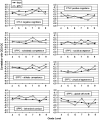Gender differences in the longitudinal structure of cognitive diatheses for depression in children and adolescents
- PMID: 19827105
- PMCID: PMC4083582
- DOI: 10.1002/jclp.20631
Gender differences in the longitudinal structure of cognitive diatheses for depression in children and adolescents
Abstract
In a school-based, four-wave, longitudinal study, children (grades 4-7) and young adolescents (grades 6-9) completed questionnaires measuring depressive symptoms and depressive cognitions, including positive and negative cognitions on the Cognitive Triad Inventory for Children (CTI-C; Kaslow, Stark, Printz, Livingston, & Tsai, 1992) and self-perceived competence on the Self-Perception Profile for Children (SPPC; Harter, 1985). Application of the Trait-State-Occasion model (Cole, Martin, & Steiger, 2005) revealed the existence of a time-invariant trait factor and a set of time-varying occasion factors. Gender differences emerged, indicating that some cognitive diatheses were more trait-like for girls than for boys (i.e., positive and negative cognitions on the CTI-C; self-perceived physical appearance and global self-worth on the SPPC). Implications focus on the emergent gender difference in depression, the design of longitudinal studies, and clinical decisions about the implementation of prevention versus intervention programs.
Figures




Similar articles
-
Developmental changes in depressive cognitions: a longitudinal evaluation of the Cognitive Triad Inventory for Children.Psychol Assess. 2008 Sep;20(3):217-26. doi: 10.1037/1040-3590.20.3.217. Psychol Assess. 2008. PMID: 18778158
-
Peer Victimization and Harsh Parenting Predict Cognitive Diatheses for Depression in Children and Adolescents.J Clin Child Adolesc Psychol. 2016 Sep-Oct;45(5):668-680. doi: 10.1080/15374416.2015.1004679. Epub 2015 Mar 9. J Clin Child Adolesc Psychol. 2016. PMID: 25751612 Free PMC article.
-
Developmental origins of cognitive vulnerabilities to depression: review of processes contributing to stability and change across time.J Clin Psychol. 2009 Dec;65(12):1327-38. doi: 10.1002/jclp.20625. J Clin Psychol. 2009. PMID: 19827008 Free PMC article. Review.
-
Self-defeating personality and depression: a closer look.Psychol Rep. 1995 Jun;76(3 Pt 2):1167-70. doi: 10.2466/pr0.1995.76.3c.1167. Psychol Rep. 1995. PMID: 7480482
-
[Vulnerability to depression in children and adolescents: update and perspectives].Encephale. 2002 May-Jun;28(3 Pt 1):234-40. Encephale. 2002. PMID: 12091784 Review. French.
Cited by
-
Attentional biases for emotional faces in young children of mothers with chronic or recurrent depression.J Abnorm Child Psychol. 2011 Jan;39(1):125-35. doi: 10.1007/s10802-010-9438-6. J Abnorm Child Psychol. 2011. PMID: 20644991 Free PMC article.
-
Cognitive vulnerability to depression during middle childhood: Stability and associations with maternal affective styles and parental depression.Pers Individ Dif. 2013 Nov 1;55(8):892-897. doi: 10.1016/j.paid.2013.07.016. Pers Individ Dif. 2013. PMID: 25392596 Free PMC article.
-
Chronic environmental stress and the temporal course of depression and panic disorder: A trait-state-occasion modeling approach.J Abnorm Psychol. 2016 Jan;125(1):53-63. doi: 10.1037/abn0000122. Epub 2015 Nov 23. J Abnorm Psychol. 2016. PMID: 26595465 Free PMC article.
-
Racial microstressors, racial self-concept, and depressive symptoms among male African Americans during the transition to adulthood.J Youth Adolesc. 2015 Apr;44(4):898-909. doi: 10.1007/s10964-014-0199-3. Epub 2014 Oct 26. J Youth Adolesc. 2015. PMID: 25344920 Free PMC article.
-
Dimensions of Peer Sexual Harassment Victimization and Depressive Symptoms in Adolescence: A Longitudinal Cross-Lagged Study in a Swedish Sample.J Youth Adolesc. 2016 May;45(5):858-73. doi: 10.1007/s10964-016-0446-x. Epub 2016 Feb 24. J Youth Adolesc. 2016. PMID: 26910524 Free PMC article.
References
-
- Beck AT. Thinking and depression: Idiosyncratic content and cognitive distortions. Archives of General Psychiatry. 1963;9:324–333. - PubMed
-
- Beck AT. Thinking and depression: II. Theory and therapy. Archives of General Psychiatry. 1964;10:561–571. - PubMed
-
- Beck AT. Cognitive models of depression. Journal of Cognitive Psychotherapy. 1987;1:5–37.
-
- Carey MP, Faulstich ME, Gresham FM, Ruggiero L, Enyart P. Children’s Depression Inventory: Construct and discriminant validity across clinical and nonreferred (control) populations. Journal of Consulting and Clinical Psychology. 1987;55:755–761. - PubMed
-
- Ciesla JA, Cole DA, Steiger JH. Extending the Trait-State-Occasion Model: How important is within-wave measurement equivalence? Structural Equation Modeling. 2007;14:77–97.
Publication types
MeSH terms
Grants and funding
LinkOut - more resources
Full Text Sources
Medical

